
Prime Minister Narendra Modi inaugurated the second edition of the International Conference on Green Hydrogen (ICGH-2024) via video message, emphasizing India's commitment to addressing climate change and highlighting green hydrogen as a promising energy solution. The Prime Minister noted, "Green hydrogen is an emerging solution with the potential to decarbonize sectors such as refineries, fertilizers, steel, and heavy-duty transportation."
The Prime Minister outlined India’s goal to become a global leader in the production, utilization, and export of green hydrogen. The National Green Hydrogen Mission, launched in 2023, is a pivotal step towards this objective. It aims to drive innovation, build necessary infrastructure, stimulate industry growth, and attract investment in the green hydrogen sector. He highlighted that India's non-fossil fuel capacity has increased by nearly 300% over the past decade, with a remarkable 3000% growth in solar energy capacity during the same period.
Minister Prahlad Joshi emphasized the role of the National Green Hydrogen Mission in positioning India as a key player in this emerging sector. The mission is expected to attract investments totaling ₹8 lakh crore and create 6 lakh jobs. It will also reduce dependence on imported natural gas and ammonia, leading to savings of ₹1 lakh crore and contributing to a reduction in carbon emissions by 5 million metric tons by 2030.
Minister Hardeep S. Puri outlined the ambitious targets of the National Green Hydrogen Mission, including the production of 5 million metric tons of green hydrogen by 2030. Achieving this goal will require an investment of $100 billion and the development of 125 gigawatts of new renewable energy capacity. The mission aims to cut 15 million metric tons of CO2 emissions annually and will result in substantial savings on imports. It will also involve pilot projects, hydrogen hubs, and R&D initiatives, supported by a robust financial framework and incentive structure.
Bhupinder S. Bhalla, Secretary of the Ministry of New and Renewable Energy, discussed India’s achievements in renewable energy and future goals. He emphasized green hydrogen as a clean energy source with zero CO2 emissions and its diverse applications across various sectors. Bhalla also highlighted India’s ambitious green hydrogen goals aligned with the Prime Minister’s Panchamrit Plan, including achieving 500 gigawatts of non-fossil energy capacity by 2030 and reaching net-zero emissions by 2070.
India is projected to see a significant increase in hydrogen demand, with a target of 29 million metric tons of annual production by 2050. Bhalla mentioned that 152 standards have been recommended so far, with 81 already published. Prof. Ajay K. Sood, Principal Scientific Adviser to the Government of India, stressed the importance of innovative research and technological development to make green hydrogen affordable and scalable. He emphasized the need for continuous support for R&D to address challenges and fully realize the potential of green hydrogen. "India is at the forefront of a transformative era in green hydrogen. With abundant renewable resources and ambitious initiatives like the National Green Hydrogen Mission, our country is poised for global leadership," he concluded.